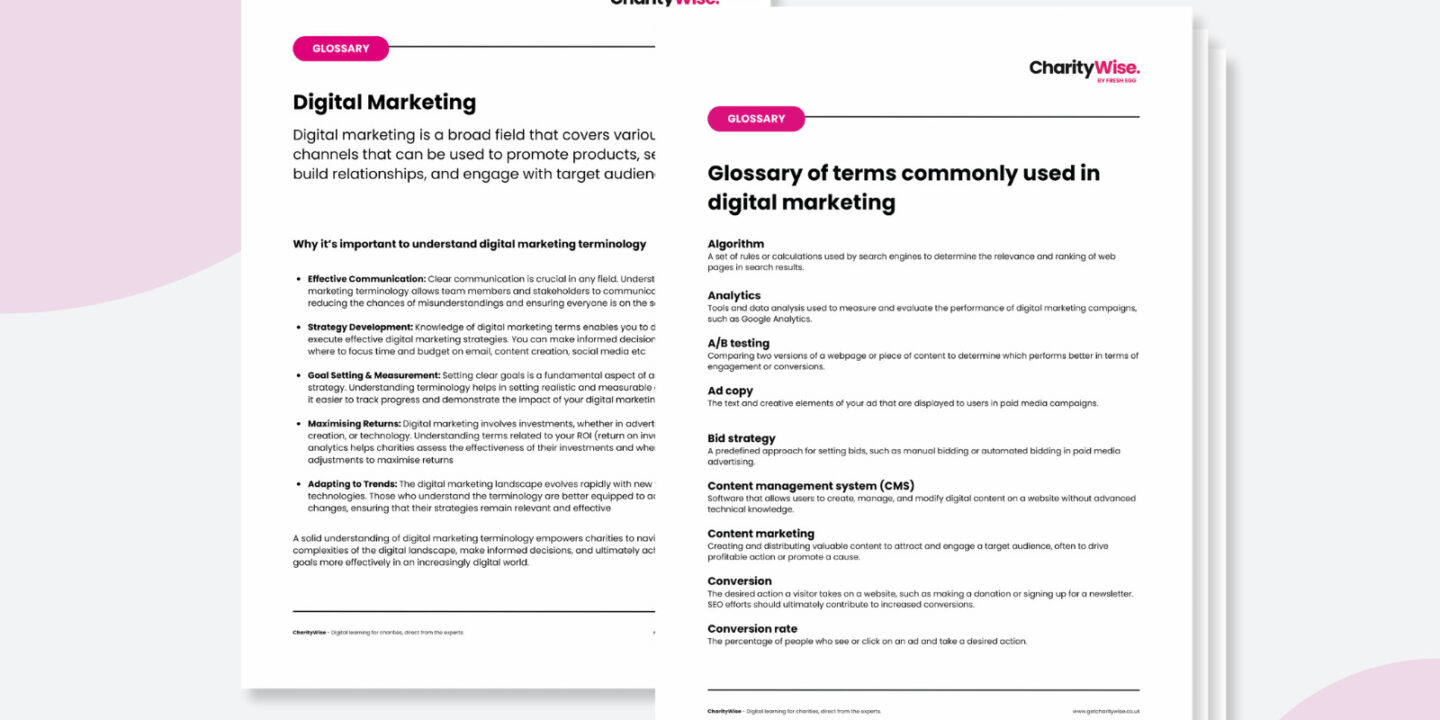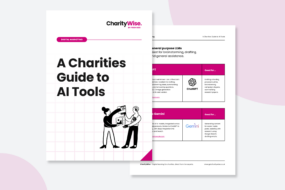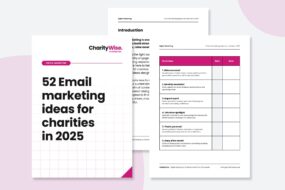

Digital marketing is a broad field that covers various online channels that can be used to promote products, services, build relationships, and engage with target audiences.
A broader understanding of digital marketing terminology empowers charities to navigate and leverage various online platforms, which are essential for connecting directly with audiences.
Why it’s important to understand digital marketing terminology
- Effective Communication: Clear communication is crucial in any field. Understanding digital marketing terminology allows team members and stakeholders to communicate effectively, reducing the chances of misunderstandings and ensuring everyone is on the same page
- Strategy Development: Knowledge of digital marketing terms enables you to develop and execute effective digital marketing strategies. You can make informed decisions about where to focus time and budget on email, content creation, social media etc
- Goal Setting & Measurement: Setting clear goals is a fundamental aspect of any marketing strategy. Understanding terminology helps in setting realistic and measurable goals, making it easier to track progress and demonstrate the impact of your digital marketing efforts
- Maximising Returns: Digital marketing involves investments, whether in advertising, content creation, or technology. Understanding terms related to your ROI (return on investment) and analytics helps charities assess the effectiveness of their investments and where to make adjustments to maximise returns
- Adapting to Trends: The digital marketing landscape evolves rapidly with new trends and technologies. Those who understand the terminology are better equipped to adapt to these changes, ensuring that their strategies remain relevant and effective
A solid understanding of digital marketing terminology empowers charities to navigate the complexities of the digital landscape, make informed decisions, and ultimately achieve their goals more effectively in an increasingly digital world.

You can also download a copy of this glossary as a handy document to refer to here:
Glossary of terms commonly used in digital marketing:
Algorithm: A set of rules or calculations used by search engines to determine the relevance and ranking of web pages in search results.
Analytics: Tools and data analysis used to measure and evaluate the performance of digital marketing campaigns, such as Google Analytics.
A/B Testing: Comparing two versions of a webpage or piece of content to determine which performs better in terms of engagement or conversions.
Ad Copy: The text and creative elements of your ad that are displayed to users in paid media campaigns.
Bid Strategy: A predefined approach for setting bids, such as manual bidding or automated bidding in paid media advertising.
Content Management System (CMS): Software that allows users to create, manage, and modify digital content on a website without advanced technical knowledge.
Content Marketing: Creating and distributing valuable content to attract and engage a target audience, often to drive profitable action or promote a cause.
Conversion: The desired action a visitor takes on a website, such as making a donation or signing up for a newsletter. SEO efforts should ultimately contribute to increased conversions.
Conversion rate: The percentage of people who see or click on an ad and take a desired action.
Cost per click (CPC): The average amount an advertiser pays for a click on their ad, in paid media advertising.
Display Network: A network of websites and apps where your ads can be displayed to a broader audience.
Crawling: The process by which search engine bots systematically browse the internet to discover and index web pages.
Call to Action (CTA): A prompt or instruction that encourages the audience to take a specific action, such as “Donate Now” or “Learn More.”
Click-Through Rate (CTR): The percentage of people who click on an ad or a link compared to the total number of people who saw it.
Digital Marketing: The promotion of products, services, or causes using digital channels such as the internet, social media, search engines, and email.
Duplicate Content: Identical or substantially similar content that appears in more than one place on the internet, which can negatively impact SEO.
Email List: A database of email addresses used for sending marketing emails. It’s essential to obtain consent from individuals before adding them to your list.
Email Marketing: Sending targeted messages to a group of people via email to promote products, services, or share information about the charity’s activities.
GDPR (General Data Protection Regulation): A European Union regulation that governs the protection of personal data, including email addresses. It requires explicit consent and provides data rights to individuals.
Geotargeting: Showing your ads to users in specific geographic locations.
Google Search Console: A free tool from Google that helps you monitor and improve your website’s performance in search results.
Headings: HTML tags that are used to structure the content on a web page and indicate its importance.
Hashtag: A word or phrase preceded by a hash (#) used on social media platforms to identify and categorise content.
Influencer Marketing: Collaborating with individuals with a significant following on social media to promote products, services, or causes.
Impressions: The number of times an ad or content is displayed, regardless of whether it is clicked or not.
Keyword: A specific word or phrase that people use to search for information online. Understanding and targeting the right keywords is crucial in digital marketing.
Key Performance Indicator (KPI): A measurable metric used to evaluate performance and track progress toward goals in business activities and projects.
Landing Page: A specific webpage designed for a targeted marketing campaign, often optimised for conversions.
Meta Description: A brief description of a web page that appears in search results pages.
Meta Tags: HTML tags that provide information about a web page to search engines. This includes the title tag and meta description, which are displayed on search engine results.
Organic Search: Natural search results that appear on a SERP based on their relevance to the user’s query, as opposed to paid advertisements.
Page Rank: A ranking algorithm developed by Google that uses backlinks to determine the authority of a web page.
Pay-Per-Click (PPC): An online advertising model where advertisers pay a fee each time their ad is clicked, commonly used in search engine advertising.
Redirect: A way to send visitors from one web page to another.
Search Engine Optimisation (SEO): The process of optimising a website to improve its visibility on search engines like Google, aiming to increase organic (non-paid) traffic.
Search Engine Results Page (SERP): The page displayed by a search engine in response to a user’s query, showing a list of websites ranked by relevance.
Segmentation: The practice of dividing your email list into smaller, targeted groups based on specific criteria, such as demographics, behaviour, or donation history.
Social Media Marketing: Promotion of products or causes on social media platforms to increase brand awareness, engagement, and website traffic.
Subscriber: An individual who has opted to receive emails from a company or organisation. Subscribers are part of an email list.
Target Audience: The specific group of people a charity aims to reach with its marketing efforts.
User-Generated Content (UGC -content created by customers or subscribers): Content created by customers or users of a product, service, or platform, rather than by the organisation or brand itself.




